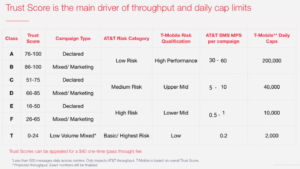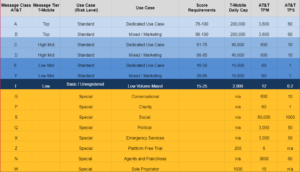Say Goodbye to the 10DLC Trust Score
When 10DLC (10-digit-longcodes) for text messaging was launched by AT&T and TMobile a ranking mechanism called “Trust Score” was introduced, along with the “Campaign Registry” which became the oversight authority brands and campaigns needed to register with. When an organization registered with the Campaign Registry they would be assigned a trust score which would dictate how many messages they could send per minute and per day on the numbers they used for any given campaign.
Over the last couple of months, the carriers and Campaign Registry have received a lot of pushback from organizations on the lack of transparency around how these trust scores were determined. If an organization got a low trust score they would have to pay a fee ranging from $40 to $2,000 to either the Campaign Registry or an authorized assessor like “Campaign Verify” have it reassessed and increased. This brought on concerns about “pay-to-play” systems being put in place by the carriers as well.

Well, it appears that the carriers and Campaign Registry were listening, because today they announced the following, “Brand Registration Score* (0-100) will be replaced by Brand Identity Status (Verified/Unverified) as a result of Brand Registration. The “Verified” status is acquired by a Brand whose EIN/Tax-id matches their Legal Company Name as submitted through TCR (The Campaign Registry).“
Is this a good thing?
Yes, but with several caveats. This is a simple verification to ensure the brand sending messages is who they say they are so they can be held accountable. If they aren’t verified then they won’t be able to send messages. But, it gets more complicated because once you read the fine print you’ll find things haven’t actually changed. Though it does appear a bit more transparency is being offered. Verification is now simply the first step.
Ok, what is the second step then?
Once you are verified, they separate brands/organizations based on the Russell 3000, which is the top three thousand publicly traded companies. If they are part of the Russel 3000 they get put into “Message Classification” group A or B and if not they are classified as E or F. If they don’t like this placement the group can hire external vetting partners to provide a “Vetting Score” which I’m sure you realize is basically the same as a “Trust Score.” So pay-to-play is still very much a real issue. Plus, this will severely hurt organizations/brands that aren’t in the Russell 3000, which is a lot of brands.
What is a Message Classification?
This is what the Trust Score originally was used for – to place brands into a classification category that would determine their throughput or how many messages they can send. Now verification, special use case, and vetting score are being used to define the classification applied to each brand. TMobile will attribute daily message caps based on the class and AT&T restricts the number of messages per minute and per second based on class.
- Standard Message has Class A-F
- Unverified or unregistered are Class T
- Special Use Cases have special Class designations which you can see below.
What about non-profit and political organizations?
Exactly! These entities have EIN/Tax IDs but are definitely not going to be falling under any corporate or Wall Street umbrella. At first look, it would appear that they are being penalized for not being a large for-profit organization. But, when you dig you’ll find that the Campaign Registry has released new definitions of what they consider “Special Use Cases” and how those use cases are treated for message delivery by the carriers. Here are some of those use cases:
Charities
Charities are defined only as 501c3 organizations, and aren’t held to a TMobile daily cap, BUT they are limited to 60 messages per minute and one message per second. They also do not need outside vetting. This is basically the same as being placed in the E or F group which is the lowest throughput allowed by the carriers. So not necessarily a win. More the status quo in a different package.
Emergency Services
501c3 nonprofit organizations and quasi-government entities are also allowed to apply for the “Emergency Services” use case which offers a better throughput of 3,000 messages per minute and 50 messages per second. So the ideal is for nonprofits to qualify under Emergency special use cases, instead of Charity. They also do not need outside vetting.
Political
According to the Campaign Registry applied to nonprofit organizations only. So my assumption is that they mean 501c4 organizations, and possibly associations and unions (501c6). But that leaves a question mark regarding what political campaigns, parties, or PACs fall under and if there is a special use case for them. This current special use case definition requires more clarification. The catch here is that any entity under this use case MUST be vetted by “Campaign Verify” which currently requires a substantial fee.
Conversational
This is for peer-to-peer app-based group messaging, with proxy/pooled numbers. This type of messaging supports personalized services and non-exposure of person numbers for enterprise or A2P communications. This could apply to the political & civic engagement P2P messages sent by non-profit and political organizations, but further clarification is needed. This special use case allows for 600 messages per minute and 10 per second. So slightly higher than the lower tier groups, no TMobile message caps, and not external vetting requirements.
Social
This is defined as communications between public figures/celebrities and their communities. So this could be applied to elected officials messaging their constituents, or possibly their campaigns messaging voters. But it needs further clarification. This special use case offers the best throughput options at up to 60,000 messages per minute and 1,000 messages per second. But, TMobile hasn’t yet authorized this special use case so we don’t know if caps will be applied. The other catch is that external vetting through Aegis or WMC Global is required and likely requires a hefty fee.
What does this mean for organizations already registered?
Previously registered Brands will be automatically checked without any additional fee and their status displayed on the “Brand details” page of their Campaign Registry profile. If one or more brands fail to pass the identity check they will notify your “Communications Service Provider” directly (ie. Twilio, Signal Wire, Bandwidth, ThruText, etc.). Obtaining a “Verified” status is a requirement for brands to register new 10DLC campaigns. Brands/Organizations will need to apply for special use cases and/or be evaluated by an outside vetting agency to change the “Message Classification” group they’ll be assigned besides the standard A-F for tiers.
What is the impact for new Brands that need to register?
Being identified as a “Verified” Brand is now a requirement for messaging on 10DLC. Providers (ie. Texting Platforms and Aggregators like Twilio, Hustle, etc.) should resubmit those Brands with an “Unverified” status (EIN/Tax-id not matching with Legal Company Name) if they wish to register any 10DLC campaign. Resubmitting a Brand for Identity check will incur a $4 fee.
What is the impact on existing Campaigns that are being run?
The Campaign Registry anticipates that Campaigns from “Unverified” Brands will remain in a “grace period” until further notice from the carriers. After which they will not be able to run on 10DLC unless the Brand is re-registered and obtains the “Verified” status. The old brand registration Trust Score will be still displayed until 8/12/21, will not be a factor for qualification.
If anything, these changes are offering greater transparency than before, though not a lot of major changes, simply rebranding. More to come, as we dig into these new developments.
